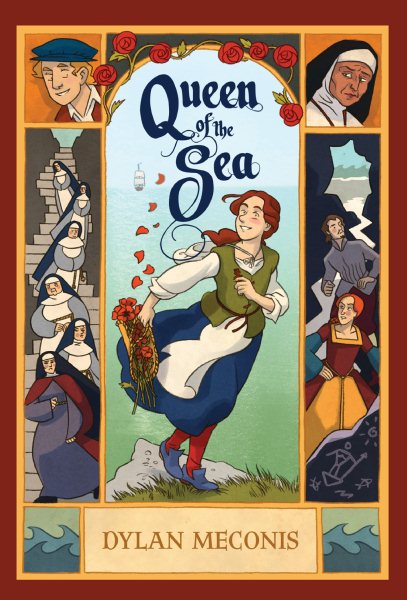Review of the Day: Queen of the Sea by Dylan Meconis

- Queen of the Sea
- By Dylan Meconis
- Walker Books (a division of Candlewick)
- $24.99
- ISBN: 978-1-5362-0498-8
- Ages 9-12
- On shelves now
With graphic novels and comics for kids being produced at a rate far more prodigious than ever before, you can get a little inured to the sameness of some of the titles. There are the personal memoirs, mostly about white girls. There are the out-of-this-world space and robot adventures. There are the magic and witch inspired fantasies. And then there are the books that sort of stand apart from the pack. What we don’t see a lot of in a given year is realistic historical fiction. You might see it once in a while, as with Hope Larson’s Compass South, Andy Hirsch’s Varmints, or Matt Phelan’s Snow White but generally speaking it’s a rarity. The idea that someone would fictionalize the life of young Queen Elizabeth I through the eyes of a child raised amongst nuns almost sounds like a crazy dare. Even so, Queen of the Sea by Dylan Meconis stands out as one of the most accomplished, even beautiful, comics of the year. Let’s see what we can do to keep it from being a secret.
The first thing you need to know about Margaret is that she wasn’t born on the Island. The second thing that you should know is that the island is full of nuns. That doesn’t bother Margaret, who loves her home and everything on it. When she prays for another child, William and his mother appear. It’s strange, but for them the Island is a prison, keeping those who have angered the King in some way apart from the rest of the world. When William leaves, his departure is followed by the arrival of two new guests. One is a lady and the other a nun of particular venom and spite. In no time at all, Margaret learns that the lady is Eleanor, the disposed queen of Albion. The two bond, but the more Margaret learns about her guest, the more she comes to grips with the fact that there is much she doesn’t know about the world. And much she doesn’t realize about herself. A fictionalized retelling of Queen Elizabeth I’s early years.
ADVERTISEMENT
ADVERTISEMENT

The choice to fictionalize the events in this book at all was such a curious one that I’ve puzzled for a while over why the choice was even made. From the get go we are told that this story takes place in a country called Albion. We are then presented with a map of the British Isles. After that, for folks who know their history, the storyline has no difficulty keeping pace with the historical record of Queen Elizabeth’s time before she came to the throne. There are certainly some additions here and there, and it is for this reason that I have to assume the author sought to separate her story from that of Elizabeth’s. Even so, I took a strange comfort in knowing the “ending”, fully aware that Meconis could upend everything in future installments, if she so desired. Had she kept this book with the real names in history, she could have taught kids some valuable history. But isn’t she teaching history with every page anyway? Reading this book you can’t help but learn about different types of stitching, or what the sea might wash onshore, or what a meal might consist of in the sixteenth-century. The choice was made with a clear purpose in mind. What that purpose might be may be revealed in subsequent sequels.
A good writer can infuse even the smallest side character with a singular personality. It’s not easy, but it can be done. Comics have the advantage of allowing the reader the chance to put a face to a name. As a result, you get little snippets of history about each of the nuns that reveals whole treasure troves of information about who they were and are. But there are two characters in this book that captured my interest most keenly. It shouldn’t surprise you that they are our heroines, Margaret and the disposed queen Eleanor. Margaret as protagonist and narrator is marvelous in part because her growth is so palpable. She goes from innocent in all things to practically wordly in the span of 394 pages. You like Margaret too. You feel for her. You may not always agree with her but you are always, always in her corner. Eleanor, however, threatens to steal the show time and again. It must have been delicious to write her. She gets to be cunning and strategic in one breath and then shortsighted and a victim of her own temper in the next. Her intelligence is biting, as is her wit, and you understand instantly why Margaret would want to spend time with her. Many is the author that has given voice to some version of Queen Elizabeth over the years, and who could blame them? She has no equal.

But can I tell you a secret? I love the writing. Love the plot and the characters and the dialogue. The whole kerschmozzle, really. But the part that I keep returning to over and over that just sets my cold little heart aglow and lifts the entire enterprise up, far above the petty rabble? I absolutely adore how Meconis chooses to illustrate different aspects of life on an island with nuns. That’s right. I’m goofy about convent process and this book provides. Now you might suspect, and with good reason, that a book that outlines the hours of the day is not going to be particularly interesting. With that in mind, Meconis infuses these selections with light and life and breath. Not satisfied with just hours, however, the author quite cleverly works in other details about day-to-day life, seamlessly integrating them into the story. If this book were a musical, then these would be the songs. As a result you get some highly amusing looks at the silent hand gestures you would have to use when you eat in the Refectory (talking is not allowed), the rules of chess, the animals kept by the sisters, etc.
I cannot claim to know a lot about comics when it comes to their specific artistry. And certainly computer wizardry has grown to the point that sometimes it’s impossible to tell when something is created by hand or on a screen. That said, I think it’s safe to say that while computer probably had a hand in the fonts and placement of words upon a page, the images themselves, for the most part, resemble nothing so much as the most incredibly adept watercolors I’ve ever seen in a comic for kids. I mean it truly when I tell you that each page in this book (with a few purposeful exceptions) is sumptuous. There’s a limited color palette, naturally. One didn’t walk around Elizabethan England wearing neon, after all. Then there is so much to be said about how Meconis uses light and shadow. You could pore over these pictures all day. They must have taken ages to finish, and every page is worth it.

Something I’ve not mentioned until now is the fact that when I looked on the publication page to see how the book was made, it didn’t mention watercolors at all. Instead it reads, “The illustrations were done in mixed media.” Why would it say that? Because one of the delights upon reading it is discovering all the little moments when the artistic style changes. For example, when Margaret is called upon to recite the trials of St. Elysia, the book takes on a style not dissimilar from those illustrated manuscripts of old. When Margaret learns to stitch fish, there appear to be real stitches, not illustrated ones, on the page (did Dylan Meconis stitch them herself? They’re awfully clever). When we see reproductions of art, they have a realism that day-to-day life can’t match. All this serves to break up the images in the text. Combined with the book’s humor, and I can stress enough how important that humor is to moving everything along, you have a book that can engage a child reader without ever boring them.
Because graphic novels and comics still occupy this in-between space where they’re respected, but only up to a point, they do not win great literary awards. Nor, for that matter, do they often win awards for visual merit. There are some exceptions to this, and I am grateful whenever a book that integrates text and image in new and interesting ways manages to break free of the expectations surrounding it. However, for all that a book like Queen of the Sea deserves every award you can name, the likelihood is that it will be insufficiently appreciated in its time. And yet, I have to believe that the combination of excellent writing, stunning art, and a storyline that will engage and entrance readers, will yield some kind of appreciation somewhere. There is no other book like this one on the market today for young people. Maybe that’s a good thing. You wouldn’t want every book for kids to be as good as this. If they were, where would the fun be in discovering something this thoroughly enjoyable? There are kids out there that like comics and like realism and have long been starved for illustrated stories of the past. Hand them this book, and then hand it to all the science fiction and fantasy enthusiasts too, because this is a book for everyone. Impossible to forget, undeniable in its delights.
On shelves now.
Source: Final copy sent for review.
Filed under: Best Books, Best Books of 2019, Reviews, Reviews 2019
About Betsy Bird
Betsy Bird is currently the Collection Development Manager of the Evanston Public Library system and a former Materials Specialist for New York Public Library. She has served on Newbery, written for Horn Book, and has done other lovely little things that she'd love to tell you about but that she's sure you'd find more interesting to hear of in person. Her opinions are her own and do not reflect those of EPL, SLJ, or any of the other acronyms you might be able to name. Follow her on Twitter: @fuseeight.
ADVERTISEMENT
ADVERTISEMENT
SLJ Blog Network
9 Randomly Random Facts About CABOOSE
Recent Graphic Novel Deals, January 2025 | News
Goodbye for now
When Book Bans are a Form of Discrimination, What is the Path to Justice?
Book Review: All Better Now by Neal Shusterman
ADVERTISEMENT








I purchased a copy today at the book shop at the Bristol Renaissance Faire, the perfect venue!
Ideal! And I’m so pleased to hear that they had it on hand. That’s forward thinking of them.